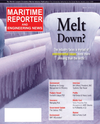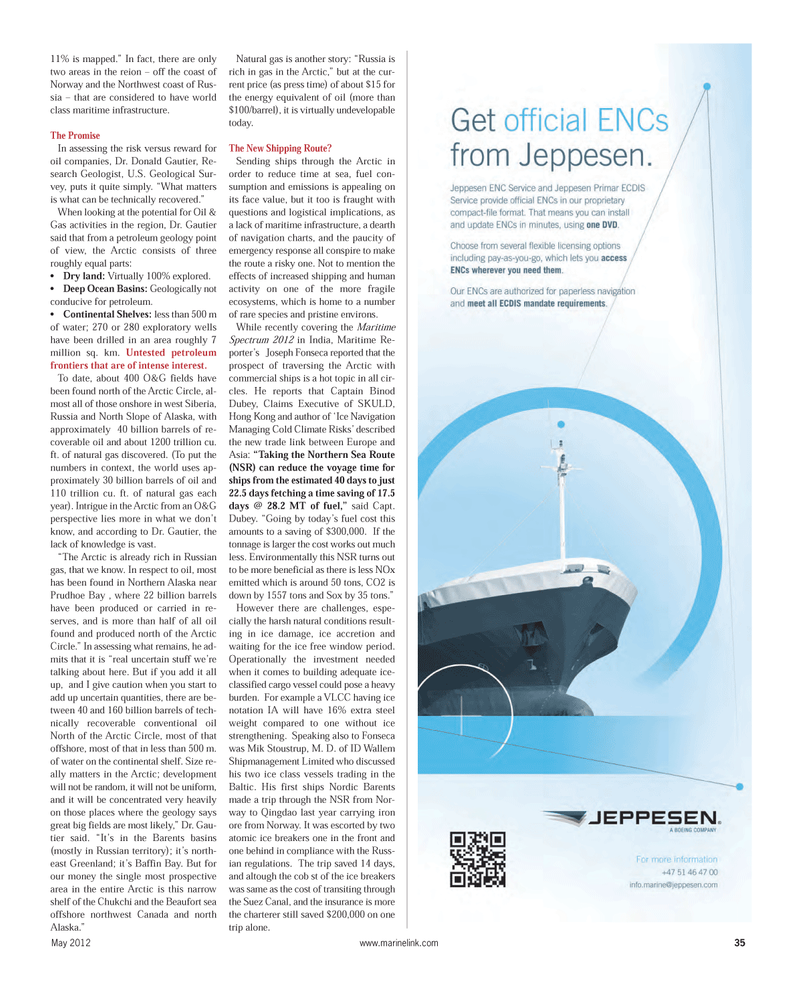
Page 35: of Maritime Reporter Magazine (May 2012)
The Green Ship Edition
Read this page in Pdf, Flash or Html5 edition of May 2012 Maritime Reporter Magazine
11% is mapped.? In fact, there are only two areas in the reion ? off the coast of Norway and the Northwest coast of Rus- sia ? that are considered to have world class maritime infrastructure.The Promise In assessing the risk versus reward for oil companies, Dr. Donald Gautier, Re- search Geologist, U.S. Geological Sur- vey, puts it quite simply. ?What matters is what can be technically recovered.? When looking at the potential for Oil &Gas activities in the region, Dr. Gautier said that from a petroleum geology pointof view, the Arctic consists of three roughly equal parts:Dry land: Virtually 100% explored. Deep Ocean Basins: Geologically notconducive for petroleum. Continental Shelves: less than 500 mof water; 270 or 280 exploratory wells have been drilled in an area roughly 7 million sq. km. Untested petroleum frontiers that are of intense interest. To date, about 400 O&G fields have been found north of the Arctic Circle, al-most all of those onshore in west Siberia,Russia and North Slope of Alaska, with approximately 40 billion barrels of re-coverable oil and about 1200 trillion cu. ft. of natural gas discovered. (To put the numbers in context, the world uses ap- proximately 30 billion barrels of oil and110 trillion cu. ft. of natural gas each year). Intrigue in the Arctic from an O&G perspective lies more in what we don?t know, and according to Dr. Gautier, the lack of knowledge is vast. ?The Arctic is already rich in Russian gas, that we know. In respect to oil, most has been found in Northern Alaska near Prudhoe Bay , where 22 billion barrelshave been produced or carried in re- serves, and is more than half of all oil found and produced north of the Arctic Circle.? In assessing what remains, he ad- mits that it is ?real uncertain stuff we?re talking about here. But if you add it allup, and I give caution when you start to add up uncertain quantities, there are be-tween 40 and 160 billion barrels of tech-nically recoverable conventional oil North of the Arctic Circle, most of that offshore, most of that in less than 500 m. of water on the continental shelf. Size re- ally matters in the Arctic; development will not be random, it will not be uniform,and it will be concentrated very heavily on those places where the geology saysgreat big fields are most likely,? Dr. Gau- tier said. ?It?s in the Barents basins (mostly in Russian territory); it?s north- east Greenland; it?s Baffin Bay. But for our money the single most prospective area in the entire Arctic is this narrow shelf of the Chukchi and the Beaufort seaoffshore northwest Canada and north Alaska.? Natural gas is another story: ?Russia is rich in gas in the Arctic,? but at the cur- rent price (as press time) of about $15 forthe energy equivalent of oil (more than $100/barrel), it is virtually undevelopable today. The New Shipping Route?Sending ships through the Arctic in order to reduce time at sea, fuel con-sumption and emissions is appealing onits face value, but it too is fraught with questions and logistical implications, asa lack of maritime infrastructure, a dearthof navigation charts, and the paucity of emergency response all conspire to make the route a risky one. Not to mention the effects of increased shipping and human activity on one of the more fragile ecosystems, which is home to a numberof rare species and pristine environs. While recently covering the MaritimeSpectrum 2012in India, Maritime Re-porter?s Joseph Fonseca reported that the prospect of traversing the Arctic with commercial ships is a hot topic in all cir- cles. He reports that Captain BinodDubey, Claims Executive of SKULD, Hong Kong and author of ?Ice Navigation Managing Cold Climate Risks? described the new trade link between Europe and Asia: ?Taking the Northern Sea Route (NSR) can reduce the voyage time for ships from the estimated 40 days to just 22.5 days fetching a time saving of 17.5 days @ 28.2 MT of fuel,? said Capt.Dubey. ?Going by today?s fuel cost this amounts to a saving of $300,000. If the tonnage is larger the cost works out much less. Environmentally this NSR turns out to be more beneficial as there is less NOx emitted which is around 50 tons, CO2 isdown by 1557 tons and Sox by 35 tons.? However there are challenges, espe- cially the harsh natural conditions result-ing in ice damage, ice accretion andwaiting for the ice free window period. Operationally the investment needed when it comes to building adequate ice- classified cargo vessel could pose a heavy burden. For example a VLCC having ice notation IA will have 16% extra steel weight compared to one without icestrengthening. Speaking also to Fonseca was Mik Stoustrup, M. D. of ID Wallem Shipmanagement Limited who discussedhis two ice class vessels trading in the Baltic. His first ships Nordic Barents made a trip through the NSR from Nor- way to Qingdao last year carrying iron ore from Norway. It was escorted by two atomic ice breakers one in the front and one behind in compliance with the Russ-ian regulations. The trip saved 14 days, and altough the cob st of the ice breakers was same as the cost of transiting through the Suez Canal, and the insurance is morethe charterer still saved $200,000 on one trip alone. May 2012www.marinelink.com 35MR May 12 # 5 (34-41):MR Template 5/8/2012 9:46 AM Page 35

 34
34

 36
36
